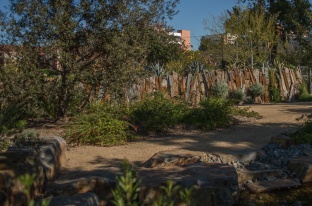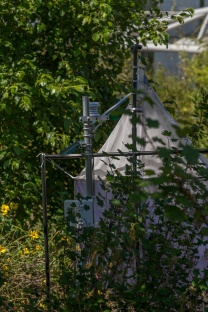Proving that scientists don’t have to travel to exotic and far-flung locations to discover new species, encounter biodiversity and track wildlife on the move, the folks at the Natural History Museum will open their much-anticipated Nature Lab and Nature Gardens to the public on Sunday, June 9, 2013.
A combination outdoor lab, learning center and very pretty place to hang out near USC, the 4 ½ acre Nature Gardens was planted last year. The green space replaced an existing parking lot with a small waterfall, pond and plenty of alders, willows, flowering shrubbery, native and non-native plants that should entice critters to set up homes or, at the very least, be the perfect stopover place.


Indeed, the landscape planting (provided by Mia Lehrer + Associates with lots of biologist input) are proving fruitful. Since its inception, 150 species of birds and mammals have been recorded flittering overhead, splashing in the pond or creeping in the underbrush of the Nature Gardens. Motion detection cameras are routinely snapping hawks, possums, songbirds and more enjoying the water.
The unusual living wall – rock slabs positioned vertically and punctuated with plants — is already providing cubby holes homes for bugs and spiders. Will SoCal reptiles like the Western fence or alligator lizard come? Only time will tell. So far, no lizards or snakes have been seen…but herp lovers are perpetually hopeful.

As lovely as all this urban paradise sounds, the Nature Gardens has an academic purpose: the Gardens will be an active field research site where scientists and the public can see what and how wildlife returns to a highly urbanized area once paved over by asphalt. As curator of herpetology, Dr. Greg Pauly, explains, “Stuff will show up here. It’s just a matter of when and what. That’s what we want to know.”
Hidden under a shade tree, a Malaise trap is luring in flying insects ….starting a three-year process to discover just what kind of bugs live in the LA area.
The new Biodiversity Science: City and Nature (BioSCAN) program involves sampling stations with similar Malaise traps at 30 other households strategically located from the NHM all the way to Santa Monica Mountains.

Collected insects are brought into the museum for cataloguing – with citizen volunteers invited to join – to create a more-focused picture of LA’s numerous bug populations.
- INTENSIVE TASK – Separating out the collected bugs..or is it an art project? (PHOTO BY MARTHA BENEDICT)
In fact, the insect work will be highlighted at a new multi-media interactive Nature Lab that puts the wildlife of LA in personal perspectives with touchable specimens, live animals and citizen scientist projects. The Lab also features firsthand accounts of growing up seeing wildlife in various LA neighborhoods, a memory map of critters that an urban school discovered when they planted a garden, and autobiographical accounts of local urban wildlife (such as the time a deer was seen from a bar in downtown Los Angeles…really!)
The exhibit will also answer those ever-present LA wildlife questions: How to tell the difference between a brown and black rat? What do mockingbirds look like? What lives underground in the LA region? What do those loud noisy parrots eat? Just how detrimental are feral cats?

All in all, when the indoor nature exhibit and outdoor Nature Gardens opens on June 9, the landscape, plants, environment and wildlife stories will be, no doubt, strikingly familiar to visitors – (“I see that tree all the time,” “My neighbors have that plant,” “Those birds are always flying near my school”) and that’s the point.
The Greater Los Angeles area is a biodiversity smorgasbord for wildlife (we have the most birds species of any county in the US) and it’s about time we turn the microscope on ourselves. Gentlemen, let the investigations begin!
Story by Brenda Rees, Photos by Martha Benedict

